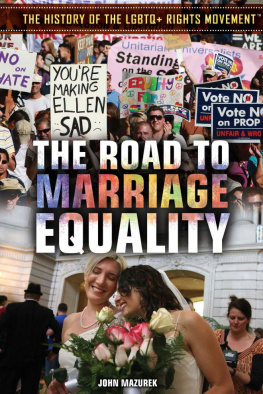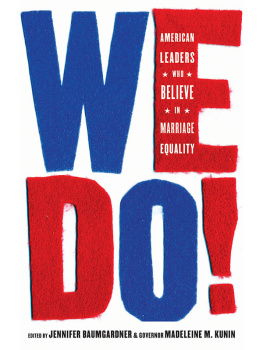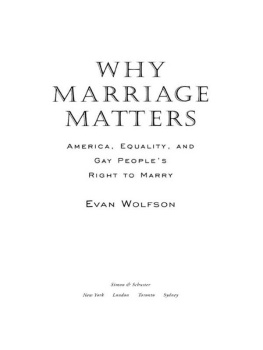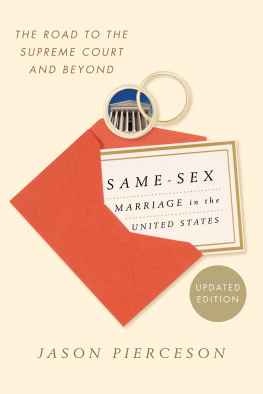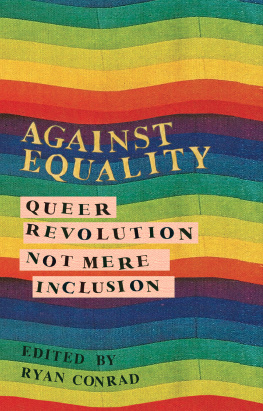John Mazurek - The Road to Marriage Equality
Here you can read online John Mazurek - The Road to Marriage Equality full text of the book (entire story) in english for free. Download pdf and epub, get meaning, cover and reviews about this ebook. year: 2018, publisher: RosenGroup, genre: Politics. Description of the work, (preface) as well as reviews are available. Best literature library LitArk.com created for fans of good reading and offers a wide selection of genres:
Romance novel
Science fiction
Adventure
Detective
Science
History
Home and family
Prose
Art
Politics
Computer
Non-fiction
Religion
Business
Children
Humor
Choose a favorite category and find really read worthwhile books. Enjoy immersion in the world of imagination, feel the emotions of the characters or learn something new for yourself, make an fascinating discovery.
- Book:The Road to Marriage Equality
- Author:
- Publisher:RosenGroup
- Genre:
- Year:2018
- Rating:5 / 5
- Favourites:Add to favourites
- Your mark:
- 100
- 1
- 2
- 3
- 4
- 5
The Road to Marriage Equality: summary, description and annotation
We offer to read an annotation, description, summary or preface (depends on what the author of the book "The Road to Marriage Equality" wrote himself). If you haven't found the necessary information about the book — write in the comments, we will try to find it.
The Road to Marriage Equality — read online for free the complete book (whole text) full work
Below is the text of the book, divided by pages. System saving the place of the last page read, allows you to conveniently read the book "The Road to Marriage Equality" online for free, without having to search again every time where you left off. Put a bookmark, and you can go to the page where you finished reading at any time.
Font size:
Interval:
Bookmark:



Published in 2019 by The Rosen Publishing Group, Inc.
29 East 21st Street, New York, NY 10010
Copyright 2019 by The Rosen Publishing Group, Inc.
First Edition
All rights reserved. No part of this book may be reproduced in any form without permission in writing from the publisher, except by a reviewer.
Library of Congress Cataloging-in-Publication Data
Names: Mazurek, John, author.
Title: The road to marriage equality / John Mazurek. Description: New York : Rosen Publishing, 2019. | Series: The history of the LGBTQ+ rights movement |
Includes bibliographical references and index. | Audience: Grades 7-12.
Identifiers: LCCN 2017030244 | ISBN 9781538381328 (library bound) | ISBN 9781508183105 (pbk.)
Subjects: LCSH: Same-sex marriageUnited States HistoryJuvenile literature. | Gay rightsUnited States HistoryJuvenile literature.
Classification: LCC HQ1034.U5 P37 2018 | DDC 306.84/80973dc23
LC record available at https://lccn.loc.gov/2017030244
Manufactured in the United States of America
On the cover : Protestors carry signs during a November 15, 2008, march in San Francisco opposing a California statewide ban on same-sex marriage (top). Amber Weiss (left) and Sharon Papo (right) stand outside the San Francisco City Hall in June 2008 ahead of their marriage ceremony ( bottom ).
CHAPTER ONE
THE NEW CAMPAIGN
CHAPTER TWO
BILLS, BILLS, BILLS
CHAPTER THREE
NEW AVENUES FOR CHANGE: ACTION IN THE STATES
CHAPTER FOUR
MAJOR MILESTONES
CHAPTER FIVE
THE CHANGING TIDE
CHAPTER SIX
OVERTURNING DOMA AND THE LEGALIZATION OF SAME-SEX MARRIAGE
CHAPTER SEVEN
MOVING BEYOND MARRIAGE

L GBTQ+ history has many compartments. Every different type of member of the community has a unique set of needs, and they share a unique history of oppression. Different types of communities under the queer umbrella have sometimes conflicted with each other and acted against the others interests, but thats not to say that they have never worked together.
The topic of same-sex marriage is one that is particular to gay people and other people who have same-sex attraction that they might want to express in the institution of marriage. As such, victories and defeats in the name of same-sex marriage havent changed the capabilities of asexual individuals, transgender people, or other communities that dont necessarily identify as holding same-sex attraction. This means that straight asexuals and transgender people would likely be acting as allies when focusing on issues to do with marriage equality unless they had an invested interest that offered them the direct benefit of gaining a right.
Marriage is an institution that many people view as the ultimate commitment between two partners, but it is also a legal institution that confers rights and protections. That is why for most of American history, same-sex partners had been denied something far greater than a piece of paper when they were turned away from their attempts to receive a marriage license. To be denied marriage also meant to be denied protections that included the right to exist as a family unit, the right to make legal decisions as a parent or spouse, and the right to self-govern ones family in a way that is agreeable to the law.
The road to marriage equality from 1990 to the present is the story of what it was like to live in a country where one could pay taxes, vote, or even risk ones life for ones nation by serving in the military and still be treated like a second-class citizen. The story is not a single narrative that is composed of a clear beginning, middle, and end. It is instead composed of hundreds of stories, court cases, protests, legal battles, and pieces of legislation that are indelibly intertwined and connected to the larger idea of equality.
Although discrimination remains a harmful facet of being a queer person in America, many actors have taken great strides over the last three decades to secure basic civil liberties. The progress can be measured as such: In 1990, many American citizens did not believe it was possible that they might someday live in a country where they could marry a same-sex partner. Yet, Obergefell v. Hodges made that reality possible in 2015, long enough after the storys beginning that some who fought for marriage equality over the decades never saw it federally mandated. Still, many fights lie ahead for the LGBTQ+ community because no victory is guaranteed to last.

M embers of the LGBTQ+ community faced major roadblocks in the fight for equality, civil rights, and acceptance at the start of the 1990s. Violence, routine discrimination in both public and private sectors of life, and lack of representation in media and the government were often awaiting the opportunity to afflict queer individuals and whole communities with some crisis. The conservative backlash that followed the AIDS crisis of the 1980s further complicated the liberation movement on a national scale.
In contrast, during the years leading up to 1992, the fight for same-sex marriage and equality at large had only witnessed a few strides forward. Civil rights for sexual minorities in particular began to find increasing public and vocal support in pockets across the country. The conversation, itself, eventually gained enough traction to become a central issue in the 1992 presidential election.
On April 28, 1990, a pipe bomb consisting of three firecrackers exploded inside of Uncle Charlies, a West Village bar in New York City frequented by members of the LGBTQ+ community. Three people were injured and dozens of patrons rushed into the street in a panic.
In the early 1990s, the rate of hate crimes continued to skyrocket across the country, and both state and federal law provided little protection for its targets. The Hate Crime Statistics Act of 1990, signed into law by President George H. W. Bush, urged for better reporting of hate-based crimes by the Federal Bureau of Investigation (FBI), but at that time, federal hate crime laws failed to recognize gender or sexual orientation as motivating factors for violence, which often resulted in the underreporting of crimes by victims. The government thus held an indifferent attitude toward the fact of hate crimes as gendered or heteronormative violence.
Advocates, organizations, and individual states therefore had to create their own systems of reporting and accountability in order to publicize and combat violence. One such organization, the New York City Gay and Lesbian Anti-Violence Project, shed light on the severity of this issue. They revealed that the number of reported antigay crimes increased from 308 to 507 between 1989 and 1990 in New York City alone.

Protestors gather outside of Borough Hall in Brooklyn, New York, on February 2, 1990. They are drawing attention to the death of James Zappalorti, a man who was killed in an act of antigay violence.
Font size:
Interval:
Bookmark:
Similar books «The Road to Marriage Equality»
Look at similar books to The Road to Marriage Equality. We have selected literature similar in name and meaning in the hope of providing readers with more options to find new, interesting, not yet read works.
Discussion, reviews of the book The Road to Marriage Equality and just readers' own opinions. Leave your comments, write what you think about the work, its meaning or the main characters. Specify what exactly you liked and what you didn't like, and why you think so.

